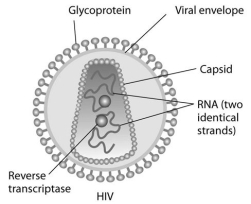Question 69
(Multiple Choice)
Use the following information to answer the questions below.
Human immunodeficiency virus (HIV)infects cells that have both CD4 and CCR5 cell surface molecules.The viral nucleic acid molecules are enclosed in a protein capsid,and the protein capsid is itself contained inside an envelope consisting of a lipid bilayer membrane and viral glycoproteins.One hypothesis for viral entry into cells is that binding of HIV membrane glycoproteins to CD4 and CCR5 initiates fusion of the HIV membrane with the plasma membrane,releasing the viral capsid into the cytoplasm.An alternative hypothesis is that HIV gains entry into the cell via receptor-mediated endocytosis,and membrane fusion occurs in the endocytotic vesicle.To test these alternative hypotheses for HIV entry,researchers labelled the lipids on the HIV membrane with a red fluorescent dye.

-If HIV first enters the cell in an endocytotic vesicle,instead of directly fusing with the plasma membrane,then
A)HIV infection should be hindered by microtubule polymerization inhibitors such as nocodazole.
B)HIV infection should be more efficient at lower temperatures.
C)intact cortical actin microfilaments should interfere with HIV infection.
D)cells lacking integrins should be resistant to HIV infection.
E)addition of ligands for other cell-surface receptors to stimulate their endocytosis should increase the efficiency of HIV infection.
Answer